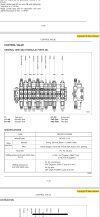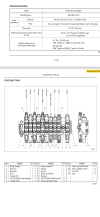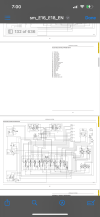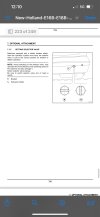-
Thank you for visiting HeavyEquipmentForums.com! Our objective is to provide industry professionals a place to gather to exchange questions, answers and ideas. We welcome you to register using the "Register" icon at the top of the page. We'd appreciate any help you can offer in spreading the word of our new site. The more members that join, the bigger resource for all to enjoy. Thank you!
You are using an out of date browser. It may not display this or other websites correctly.
You should upgrade or use an alternative browser.
You should upgrade or use an alternative browser.
Return filter blocked???
- Thread starter Despo1998
- Start date
funwithfuel
Senior Member
It does, that first illustration showing you to measure and adjust oil pressure. So it appears you have the pressure reducing valve on a manifold with 2 solenoids. That makes sense since your isolating 2 pumps. You want to make sure your pilot oil , measured at P3 is correct. If it's low, you will have reduced travel to each spool since the pressure, even fully stroked, will be insufficient to fully stroke the spool.
Typically most machines run 450 to 475 psi. Or if you use bar between 30 and 33. Once you verify you have correct pilot oil pressure, you need to make sure that pressure is making it to the RCVs. So, you have 2 solenoids. Assuming 1 for blade and swing, and the other for digging/travel. Since all functions are weak, we have to look at voltage and ground to the solenoids. We're looking for common denominators. What effects both? If you have the fitting, you'll want to measure the pressure out at the pilot pressure manifold with the armrest up and down. Should be less than 1 bar up and should be same as P3 when down. If pressure is low, measure voltage at solenoids... While the solenoid is plugged in. It's important to measure under load. Unloaded you may have battery voltage but under load, it may drop to 1 volt, you won't know till you verify.
Typically most machines run 450 to 475 psi. Or if you use bar between 30 and 33. Once you verify you have correct pilot oil pressure, you need to make sure that pressure is making it to the RCVs. So, you have 2 solenoids. Assuming 1 for blade and swing, and the other for digging/travel. Since all functions are weak, we have to look at voltage and ground to the solenoids. We're looking for common denominators. What effects both? If you have the fitting, you'll want to measure the pressure out at the pilot pressure manifold with the armrest up and down. Should be less than 1 bar up and should be same as P3 when down. If pressure is low, measure voltage at solenoids... While the solenoid is plugged in. It's important to measure under load. Unloaded you may have battery voltage but under load, it may drop to 1 volt, you won't know till you verify.
Okay so this is where I’m atIt does, that first illustration showing you to measure and adjust oil pressure. So it appears you have the pressure reducing valve on a manifold with 2 solenoids. That makes sense since your isolating 2 pumps. You want to make sure your pilot oil , measured at P3 is correct. If it's low, you will have reduced travel to each spool since the pressure, even fully stroked, will be insufficient to fully stroke the spool.
Typically most machines run 450 to 475 psi. Or if you use bar between 30 and 33. Once you verify you have correct pilot oil pressure, you need to make sure that pressure is making it to the RCVs. So, you have 2 solenoids. Assuming 1 for blade and swing, and the other for digging/travel. Since all functions are weak, we have to look at voltage and ground to the solenoids. We're looking for common denominators. What effects both? If you have the fitting, you'll want to measure the pressure out at the pilot pressure manifold with the armrest up and down. Should be less than 1 bar up and should be same as P3 when down. If pressure is low, measure voltage at solenoids... While the solenoid is plugged in. It's important to measure under load. Unloaded you may have battery voltage but under load, it may drop to 1 volt, you won't know till you verify.
I’m not able to test the pressure on the other side of the solenoid valve block just yet as I’m waiting for fittings to arrive, but the voltages are all good with safety lock up and down. But after googling the particular solenoids I have I can see that they have a set of 3 o-rings and I’m thinking any of them could potentially be damaged and that might cause because there may be some internal leaking??
funwithfuel
Senior Member
I would have to say, you're going to have to verify oil pressures one step at a time. First, verify pilot oil to the manifolds. Are you seeing your 30 bar at the joysticks? Once you've established that, pick a function, boom, arm, whatever. Place gauged fittings at either side. There should be no pressure until you request a function. You should see a proportional rise in pressure as you stroke the joystick for that function. This will tell you if your control valve is even being told what to do. Let's look at the low pressure side of things first, since that's where everything starts.
I don't know about what fittings you have, whether JIC, ORFS, BSPP or NPT. You should be able to score a cheap set of China gauges and T fittings off Temu or Amazon or Ebay. Good luck.
I don't know about what fittings you have, whether JIC, ORFS, BSPP or NPT. You should be able to score a cheap set of China gauges and T fittings off Temu or Amazon or Ebay. Good luck.
funwithfuel
Senior Member
The magnets, when energized, will they grab and hold a screwdriver? Did you ohm out the resistance of the coils. What was the voltage compared to battery voltage?Okay so iv checked the voltages and have pulled the solenoids out and went over them checked if they were working out of the machine to and all seem to be in working order
As far as I checked and compared to the specs I have on the solenoids they seem to be in perfect working order. I even went out and bought a new multimeter to verify. Iv ordered a tee pressure test kit so I can start testing pressures at the lines instead of just at the pump. I still don’t fully understand the piston pump side of pressure testing because my gauges show that both P1 and P2 are only making 200psi when I move the joysticks
funwithfuel
Senior Member
Kind of a "cliffnotes" version . Hope it helps.
Alright so iv tested the pressure between the solenoid block and valve block and the pressure seems very good. I’m yet again at a block and unsure what to test or go from here.
Now when I bought the machine the guy said that his employee sometimes changes the controls from standard to backhoe, from what I can see there’s no valve or anything as such to change this on my machine
Now when I bought the machine the guy said that his employee sometimes changes the controls from standard to backhoe, from what I can see there’s no valve or anything as such to change this on my machine
funwithfuel
Senior Member
If you were having problems with only boom and arm, the pattern change valve would be the most likely culprit. I'm gonna have to look at your schematic when I can look at it bigger than my phone.
funwithfuel
Senior Member
That warning is pretty ominous.
Back to the schematic, bottom left corner, valve 13, port A. When you raise the safety you should have pressure there. I cannot read the value, but it's on the schematic. That's what you should have. From there you'll have to check at the pilot manifold (not shown in sch) it may simply be t fittings with continuous hoses. Where the pilot oil comes in to each valve, the fitting is a filter. Make sure the filters are clean. Blow them out with brake clean. Also bring a bucket and a helper. Pressure doesn't mean flow. Take a pilot hose off and put in a bucket. Start and raise safety for a second, make sure your oil isn't trickling, should come out like a fire hose. Let's see where this gets you. Good luck.
Back to the schematic, bottom left corner, valve 13, port A. When you raise the safety you should have pressure there. I cannot read the value, but it's on the schematic. That's what you should have. From there you'll have to check at the pilot manifold (not shown in sch) it may simply be t fittings with continuous hoses. Where the pilot oil comes in to each valve, the fitting is a filter. Make sure the filters are clean. Blow them out with brake clean. Also bring a bucket and a helper. Pressure doesn't mean flow. Take a pilot hose off and put in a bucket. Start and raise safety for a second, make sure your oil isn't trickling, should come out like a fire hose. Let's see where this gets you. Good luck.
I didn’t get to to what you suggested tonight but I did have another muck around with it and this is what I found. There’s a hose that goes from the solenoid block to the valve body and I thought while the machine has no hydraulic fluid in it at the moment I’ll see if the pipe is blocked or something. Dint find it was blocked or obstructed but I did find a filter screen on the valve body side and that was blocked up so after giving it a clean I tested the machine again (with hydro fluid in it) and still that same, but what I noticed tonight is when the machine is a full revs and say I pull the lever for the blade I noticed 2 things. That the hose that goes from the pump to the valve body is extremely noisy and it’s a on off sounds of noise and vibration and the blade is also very jerky/stop start as it comes up (still at a extremely slow rate) so not sure if that would suggest or tell you anything
funwithfuel
Senior Member
Noise would indicate cavitation. Either the oil is aerated or you're sucking air. I'm sure I asked, but, you did remove, inspect and clean the suction strainer? That would be a metal mesh screen that is a last chance filter for pump protection. It is fitted on top of the sump in the very bottom of the tank.
The other thing to consider is the condition of the hose between the tank sump and the pump inlet. Is it soft and pliable or hard and brittle? Can the hose clamps be tightened without breaking? Good luck
The other thing to consider is the condition of the hose between the tank sump and the pump inlet. Is it soft and pliable or hard and brittle? Can the hose clamps be tightened without breaking? Good luck
Yeah I actually checked the strainer filter tonight that’s why I had the hydro tank empty and iv replaced the rings on the pump and tank inlet flange and the hose is soft and pliable. I did notice on the hose that sounds like it has cavitation issues that there is a very slight tare or what looks like a spit that has been work out on it from rubbings on a supporting part of the body. Now it’s not leaking but it has worn through enough I can slightly see the mesh inside the hose. But from the start iv had this issues with this crazy cavitation/ vigorous vibration coming from this particular hose
funwithfuel
Senior Member
How is your tank vented, it should have something to maintain positive pressure in the tank at all times. Similar to a radiator cap or pressure release valve. In the tank, on top of the oil you should have ½ to 1 bar of tank pressure to ease cavitation problems. It's basically pushing oil into the pump. Aerated oil doesn't behave properly and leads to dieseling, which is very harmful to everything hydraulic.




